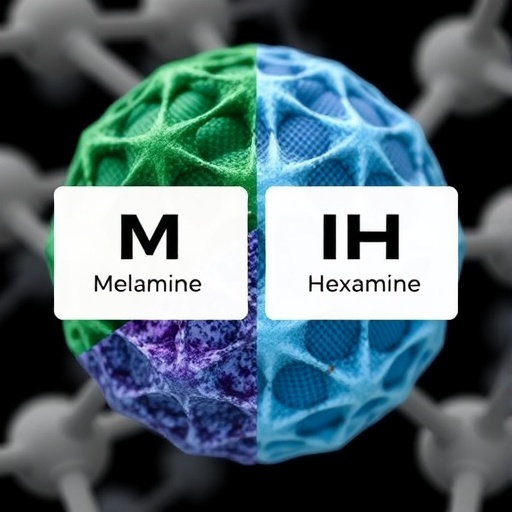In the ever-evolving world of energy storage systems, researchers are continually on the lookout for innovative materials that can enhance performance and sustainability. A recent study published in the esteemed journal Waste Biomass Valor sheds light on the intriguing interplay between nitrogen sources and the production of N-doped activated biocarbon, derived from Jatropha oilcake, aimed at supercapacitor applications. The research conducted by Sankari and Vivekanandhan explores how melamine and hexamine, two common nitrogen sources, influence the properties and effectiveness of this biocarbon.
Jatropha oilcake, a byproduct of the oil extraction process from Jatropha seeds, presents a unique opportunity not only for waste valorization but also for the development of advanced energy storage materials. The study emphasizes the significance of utilizing agricultural waste in creating N-doped activated biocarbon, which could pave the way for more sustainable practices in energy storage technologies. Given the global push towards renewable energy and environmentally friendly materials, this research is both timely and pertinent.
The researchers meticulously compared the effects of melamine and hexamine on the nitrogen doping process, which is crucial for enhancing the electrical conductivity and surface area of activated biocarbon. Both nitrogen sources were selected for their distinctive chemical properties that could yield varying impacts on the final material’s performance. The insights gained from their comparative analysis are expected to open new avenues for optimizing the production of activated carbon composites that cater specifically to high-efficiency supercapacitor applications.
Conducting a series of experiments, the researchers synthesized N-doped activated biocarbon using both melamine and hexamine. They applied rigorous characterization techniques, including BET surface area analysis and electrochemical testing, to evaluate the physical and chemical properties of the resultant materials. The findings revealed that each nitrogen source imparted unique characteristics to the biocarbon, highlighting the balance between nitrogen content, surface functionalization, and conductivity.
One of the key discoveries of the study was the enhanced surface area achieved with the use of hexamine compared to melamine. The researchers noted that the hexamine-derived biocarbon exhibited a significantly larger surface area, which is essential for maximizing charge storage in supercapacitors. This finding suggests that the choice of nitrogen precursor plays a pivotal role in tailoring the properties of carbon-based materials for specific applications.
In addition to surface area, the electrochemical performance of the N-doped activated biocarbon was meticulously assessed through cyclic voltammetry and galvanostatic charge-discharge tests. These tests evaluated parameters such as capacitance, energy density, and power density, revealing that hexamine-derived materials generally outperformed those produced with melamine. The superior performance highlights the importance of optimizing precursor materials in the overall development of advanced energy storage solutions.
Beyond performance metrics, the researchers also addressed the environmental implications of using Jatropha oilcake as a raw material. By transforming agricultural waste into a valuable resource for energy storage, this process exemplifies a circular economy concept, minimizing waste while maximizing resource utility. Furthermore, the study aligns with global sustainable development goals by promoting the use of bio-based materials.
The exploration of N-doping in activated carbon is particularly significant as it enhances electrode materials’ pseudocapacitance in supercapacitors, which is crucial for improving overall energy storage capabilities. By introducing nitrogen into the carbon matrix, researchers can create additional active sites for charge storage, leading to better performance characteristics. This research contributes to our understanding of how elemental composition can be manipulated to achieve desirable electrochemical properties in energy storage materials.
Sankari and Vivekanandhan’s findings not only provide scientific insights but also pave the way for further research into the scalability of producing N-doped activated biocarbon. The transition from laboratory-scale experiments to industrial-scale applications is a critical step in assessing the practical viability of these materials. Continued examination of cost-effective methods for synthesizing biocarbon from waste sources will be key to ensuring that this technology can be effectively integrated into the existing energy infrastructure.
With the increasing demand for efficient energy storage solutions driven by renewable energy sources, the implications of this research extend beyond academic curiosity. There is a growing need for materials that can charge and discharge rapidly, providing reliable performance in various applications from electric vehicles to grid energy storage. The study underscores the necessity of ongoing innovation in material science to meet the challenges posed by the rapidly changing energy landscape.
As the world gravitates towards cleaner energy alternatives, research such as that conducted by Sankari and Vivekanandhan exemplifies the essential role of academic inquiry in addressing practical challenges and identifying sustainable solutions. The findings of this study will likely serve as a foundation for future explorations into N-doping techniques and their applications in advanced materials, promoting a greener and more sustainable future.
In conclusion, the comparative study of melamine and hexamine as nitrogen sources provides valuable insights into the development of N-doped activated biocarbon from Jatropha oilcake for supercapacitor applications. The research not only enhances our understanding of material properties but also advances the dialogue on sustainability in energy storage technology. With the trends in research and innovation aligning toward eco-friendly solutions, the integration of such materials could significantly influence the future of energy storage systems. The successful implementation of the findings from this study could culminate in new pathways for sustainable technologies that touch upon both industrial practices and consumer use in daily life.
Subject of Research: The effects of melamine and hexamine on the production of N-doped activated biocarbon from Jatropha oilcake.
Article Title: Comparison of the Effects of Melamine and Hexamine as the Nitrogen Sources on the Production of N-Doped Activated Biocarbon from Jatropha Oilcake for Supercapacitor Applications.
Article References:
Sankari, M.K.S., Vivekanandhan, S. Comparison of the Effects of Melamine and Hexamine as the Nitrogen Sources on the Production of N-Doped Activated Biocarbon from Jatropha Oilcake for Supercapacitor Applications. Waste Biomass Valor (2025). https://doi.org/10.1007/s12649-025-03290-4
Image Credits: AI Generated
DOI:
Keywords: N-doped activated biocarbon, Jatropha oilcake, supercapacitors, nitrogen sources, melamine, hexamine, sustainable materials.
Tags: Activated Biocarbon ProductionAgricultural Waste Valorizationelectrical conductivity enhancementenergy storage materialsEnvironmental Impact of Energy StorageJatropha Oilcake UtilizationMelamine vs. HexamineNitrogen Sources for N-Doped Biocarbonrenewable energy materialssupercapacitor applicationssustainable energy technologiesWaste Biomass Valor Research





